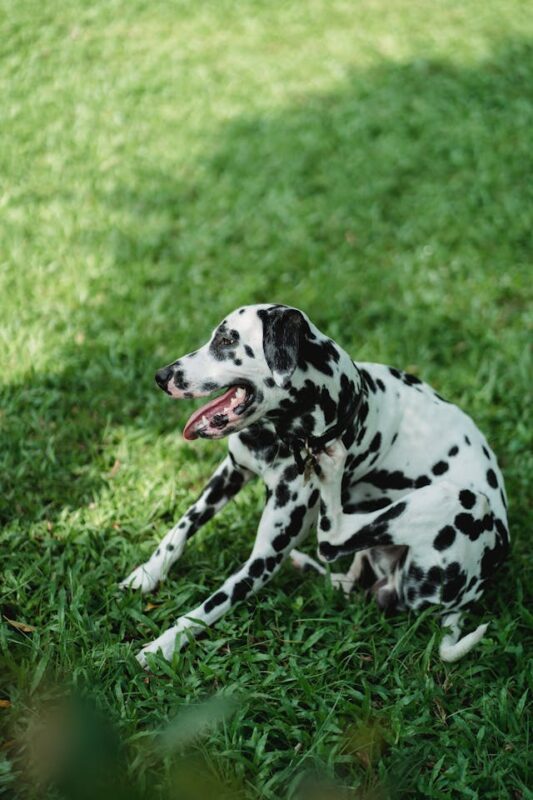Get Your Pup Ready for Spring!
Posted: 03/10/2025 | BY: Jenna Bruce | Categories: Dog , Pet care , Top Tips
As the snow melts and the days grow warmer, spring brings a fresh start—not just for us, but for our four-legged friends too! With longer daylight hours and better weather, it’s the perfect time to enjoy more outdoor activities with your pup, whether that’s hiking, camping, or just taking longer walks. But before you and your dog embrace the season, a little preparation is key. Here’s how to get your furry companion ready for springtime fun.
1. Keep Up with Regular Grooming

Springtime usually means one thing for dog owners—shedding! As your pup swaps out their thick winter coat for a lighter summer one, regular grooming can help manage all that loose fur. Brushing your dog not only keeps your home cleaner but also helps prevent matting and skin issues.
Different coat types require different brushes, so if you’re unsure which is best for your pup, consult your vet or a professional groomer. A thorough grooming routine will ensure your dog looks and feels their best for all those springtime adventures!
2. Upgrade Your Dog’s ID Tag
With the change of seasons, it’s a great time to make sure your dog’s ID tag is legible and up to date. An ID tag with your current contact details is essential in case your dog ever gets lost while exploring the great outdoors. For added security, ensure your pet is microchipped and that your contact information is registered and accurate. A little preparation now can save a lot of heartache later!
3. Protect Against Fleas, Ticks, and Heartworms
Spring’s warmer temperatures also mean the return of pests like fleas, ticks, and mosquitoes—carriers of heartworm disease. Preventative treatments are a must to keep your dog safe. Talk to your vet about year-round flea, tick, and heartworm preventatives. Whether you opt for monthly chews, topical treatments, or long-term solutions, protecting your dog from these pesky critters will keep them comfortable and healthy all season long.
4. Spring Clean Your Dog’s Space
Spring cleaning isn’t just for your home—it’s for your pup’s belongings too! Take this time to wash their bedding, blankets, and plush toys to remove dirt, dander, and bacteria. A mild, pet-safe detergent or a little vinegar will do the trick.
Don’t forget to clean and sanitize their food and water bowls, leashes, collars, and harnesses. If anything is worn out or no longer fits properly, it’s time for an upgrade. A fresh start for spring means a cleaner, healthier space for your furry friend!
5. Check Your Backyard for Hazards

After a long winter, your yard might have accumulated hidden hazards. Before letting your dog loose outside, take a walk around your property to check for fallen branches, broken fencing, or any toxic plants that may have sprouted.
Also, inspect your fence for weak spots or gaps where an adventurous pup might try to make a grand escape. A little yard maintenance now will ensure your dog can safely enjoy their outdoor time.
6. Update Your Dog’s Medical Records
Spring is a great time to schedule a vet visit and make sure your pup is up to date on vaccinations, heartworm testing, and routine checkups. Take a moment to review their records and update any necessary paperwork, including licenses and microchip information.
If you’re planning trips or outdoor excursions, some parks and campgrounds require proof of vaccinations, so staying current will help prevent any hiccups in your spring plans.
7. Hydration and Sun Protection
As temperatures rise, keeping your dog hydrated is crucial. Always bring a portable water bowl and fresh water during outdoor adventures.
In addition, some dogs, especially those with short coats or light-colored fur, are prone to sunburn. Dog-friendly sunscreen can protect their sensitive skin, particularly on the nose and ears. Staying mindful of sun safety will keep your pup comfortable on even the sunniest spring days.
8. Exercise and Training Refresh
With more opportunities to be active outdoors, spring is the perfect time to refresh your dog’s training. Work on leash manners, recall commands, and socialization skills to ensure your dog is well-behaved in new environments.
If your dog was less active during the winter, ease them into a more vigorous exercise routine to prevent injury. Gradually increasing activity levels will help your pup build endurance for all the fun adventures ahead.
9. Watch for Seasonal Allergies

Just like humans, dogs can suffer from seasonal allergies. If your pup is sneezing, itching, or experiencing watery eyes, they may be reacting to pollen or other environmental allergens.
Wiping your dog’s paws and coat after outdoor walks can help minimize allergens. If symptoms persist, consult your vet for possible treatment options such as antihistamines or allergy-friendly shampoos.
Ready for Spring Adventures?
Spring is all about fresh starts, new adventures, and making memories with your furry best friend. By taking these simple steps, you’ll set the stage for a safe and enjoyable season.
Pet Insurance, Because Accidents Happen in Any Season!
No matter how much we prepare, accidents can happen, during any season. Dogs are naturally curious and love to explore, which sometimes leads to unexpected injuries or illnesses.
Emergency vet visits can be costly, and the last thing you want to worry about during an urgent situation is finances. That’s why having pet insurance can be a lifesaver. A good pet insurance plan can help cover the costs of sudden illnesses, injuries, and even routine care, giving you peace of mind so you can focus on what matters most—keeping your pup happy and healthy.
Find & Compare the Top Pet Insurance Companies
Get Quotes for Your Dog
Disclaimer
The information contained on this blog is intended for informational and educational purposes only and should not be construed as medical advice. It is not a substitute for professional veterinary care. Always consult with your veterinarian before making any changes to your pet's health care or treatment plan.
The authors of this blog are not veterinarians and do not claim to be experts in pet health. The information provided here is based on our own experiences and research, as well as information from reputable sources. However, we cannot guarantee the accuracy or completeness of this information.
We encourage you to do your own research and consult with your veterinarian before making any decisions about your pet's health.
Compare top pet insurance providers plans.
Enter your dog’s age in years and months to calculate their age equivalent to human years.
Calculate your dog’s ageEnter your cat’s age in years and months to calculate their age equivalent to human years.
Calculate your cat’s age